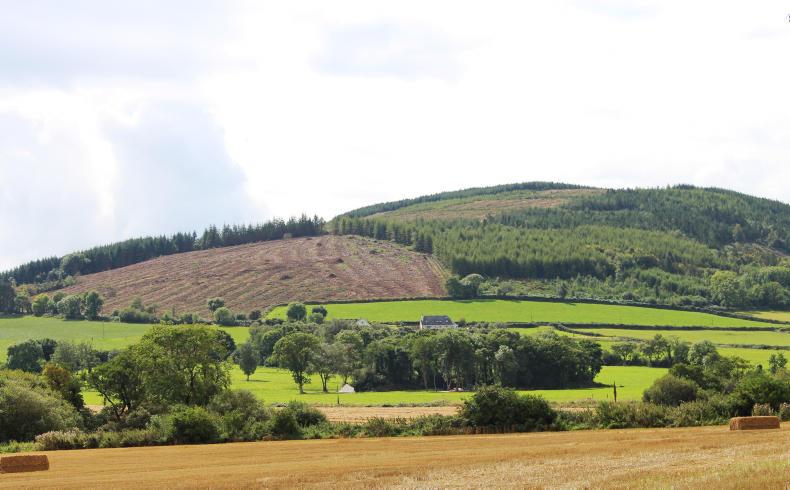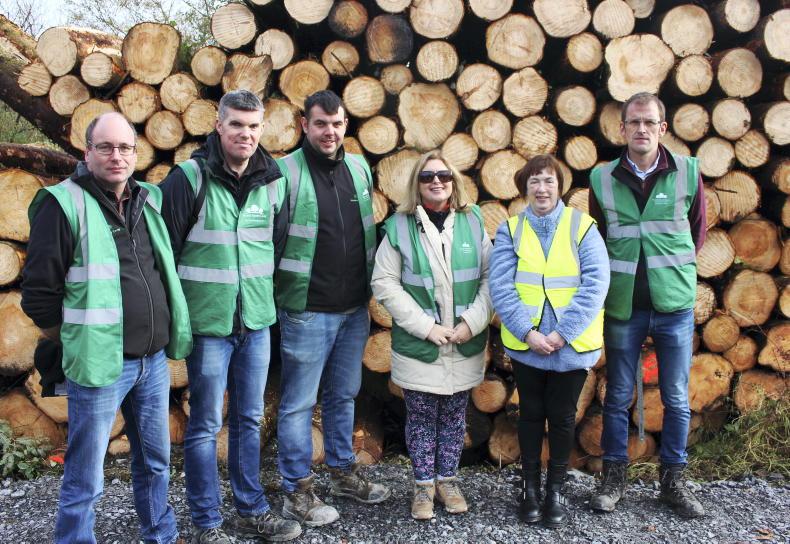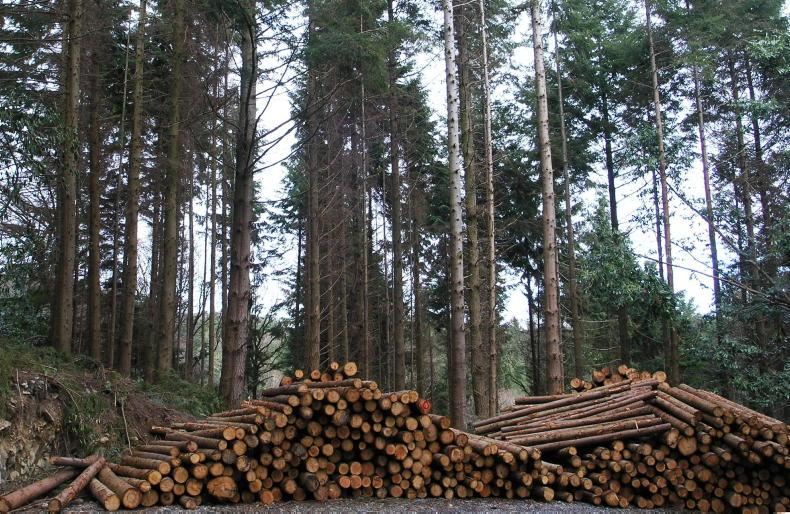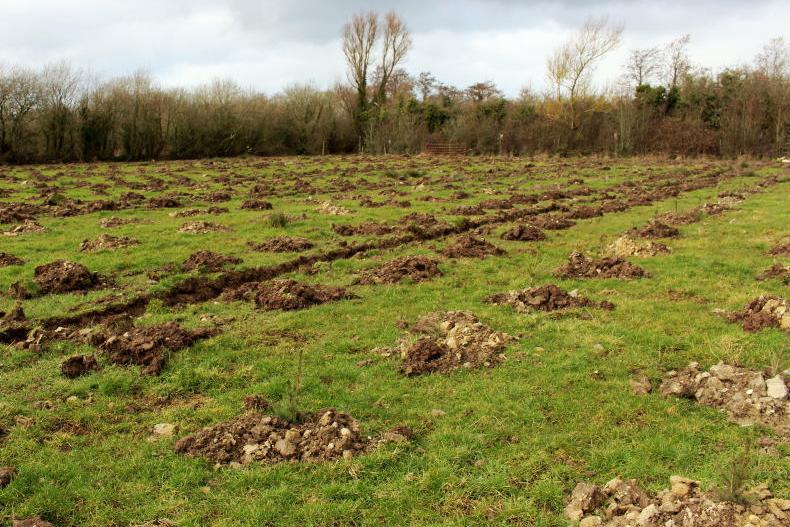Andrew Doyle, minister of state with responsibility for forestry, announced the publication of the Department’s Forest Statistics - Ireland 2017 last Friday. “The report is prepared by my Department and is the reference document for forestry statistics in Ireland,” he said. “Its thoroughness and ease of access mean that it is the definitive compendium of up-to-date information on forestry.”
The publication provides statistics about afforestation trends, nationally and on a county-by-county basis, up until the end of 2016. It tracks forest road building, thinning and clearfelling activity as well as a range of other forest management operations. Information is available on log prices but needs updating. The report also features data on employment and forest protection including fire and pest damage. Key information includes:
The area of forest (up to 2012) is estimated to be 731,650 ha or 10.5% of the total land area of Ireland. If afforestation figures for 2013 to 2017 are added, I estimate the total area of forest cover at 762,401ha (Table 1) or 10.8% of the land area. On this basis, the area of forests owned by private growers – mainly farmers – will exceed the Coíllte estate by 2019. Forest cover is estimated to be at its highest level in over 350 years. Over one-quarter of the forest estate contains broadleaves.Farmers accounted for 83% of private lands afforested between 1980 and 2016.In 2016, €103.8m was spent on forest activities including afforestation grants, maintenance grants, annual premium payments and grants for forest roading infrastructure. The average size of private grant-aided afforestation since 1980 is 8.8ha.Since 1980, nearly 21,994 private forest owners have received grant aid to establish forests. The report doesn’t provide data for the actual number of forest owners as between 30% and 40% repeat plant. A substantial area of private grant-aided forests changes ownership each year, with most ownership change within families from one generation to the next.The total roundwood harvest in 2016 (including firewood) was 3.35m cubic metres, the highest level since records began. Coíllte harvested 2.73million m3 of logs, exceeding its forecast of 2.65 million m3 while private forest owners harvested 0.62 million m3 compared with an estimated forecast of 0.98 million m3 (Table 2). This highlights the challenge facing the private sector in optimising wood mobilisation.
In 2016, 34% of the roundwood harvested was used for energy generation, mainly within the forest products sector. The usage of forest-based biomass for the energy sector abated 0.76m tonnes of CO2 emissions in 2016, up almost 22% on the 2015 level.The national forest estate is an important carbon reservoir, amounting to 381 million tonnes of carbon in 2012; an increase from 348 million tonnes in 2006.Forests also provide a source of renewable raw materials for fuel and wood products which help mitigate rises in greenhouse gases. Usage of wood fuels is increasing due to renewable energy policies and as young plantations enter the production stage. Good snapshot
Forest Statistics – Ireland 2017 provides a good snapshot of the Irish forestry and forest products sector but its main flaw lies in its lack of up-to-date data and analysis. Why information was not made available for 2017 is surprising since it is available. For example, the Irish Farmers Journal (3 March) has already published data for 2017 on afforestation, forest road construction and felling licences, all of which are missing from these statistics. These defects need to be corrected over the coming weeks.
In addition, statistics on the area and composition of the forest estate – public and private – are five years out of date. However, this is about to be rectified as the “Department will be publishing, in the coming months, results from the third cycle of the National Forest Inventory (NFI) which is completed every five years”, according to Minister Doyle. “The third NFI will facilitate the on-going monitoring of the national forest estate, including the assessment of change over time,” he said.
The annual forest statistics highlight the need for an annual up-to-date review. This would include analysis and comments on the overall performance of the sector in relation to afforestation trends, species diversity, reforestation, forest and forest land prices, timber prices, markets – domestic and exports – research and development, wood mobilisation, forest protection, employment and issues such as the role of forestry in reducing agriculture’s greenhouse gas emissions.
This type of review will require a forestry development agency with input from a wide range of relevant stakeholders throughout the sector.
Minister issues warning
on illegal burning
Minister for Agriculture Michael Creed has issued “a strong warning to farmers and their advisers” in relation to agricultural and eligible forestry land which is burned illegally during the closed season – 1 March to 31 August. “If you burn land after 1 March, you risk prosecution and such land is not eligible for payment under the Basic Payment Scheme and other area-based schemes,” he said. “Both farmers and the wider public, whether it be at work or in enjoying the countryside, should at this time of year be mindful of the damage caused by burning and should take appropriate care.”
Widespread damage was caused by forest and land fires last year. The minister clarified a number of issues in relation to penalties for illegal burning:
Inclusion of illegally burned land in the 2018 Basic Payment Scheme application may result in reduced payment and penalties under this scheme and the other area-based schemes, eg Areas of Natural Constraints Scheme. Illegal burning can also render the land of a neighbours ineligible for payment. Where it is identified that lands were burned during the closed season this may result in such land being inspected by Department officials.The Department issued its “ Forest Fire Risk Warning System 2018” last week. Forest fire danger notices are issued during the main wildfire risk season from February through to September.
These notices provide forest owners and managers with advance warning of high fire risk weather conditions, and permit appropriate readiness measures to be taken in advance of fire outbreaks.
These notices will be published in the Irish Farmers Journal during high and extreme fire risk periods.
Read more
The need for a more balanced forestry programme
Increase in forestry jobs in the west
Andrew Doyle, minister of state with responsibility for forestry, announced the publication of the Department’s Forest Statistics - Ireland 2017 last Friday. “The report is prepared by my Department and is the reference document for forestry statistics in Ireland,” he said. “Its thoroughness and ease of access mean that it is the definitive compendium of up-to-date information on forestry.”
The publication provides statistics about afforestation trends, nationally and on a county-by-county basis, up until the end of 2016. It tracks forest road building, thinning and clearfelling activity as well as a range of other forest management operations. Information is available on log prices but needs updating. The report also features data on employment and forest protection including fire and pest damage. Key information includes:
The area of forest (up to 2012) is estimated to be 731,650 ha or 10.5% of the total land area of Ireland. If afforestation figures for 2013 to 2017 are added, I estimate the total area of forest cover at 762,401ha (Table 1) or 10.8% of the land area. On this basis, the area of forests owned by private growers – mainly farmers – will exceed the Coíllte estate by 2019. Forest cover is estimated to be at its highest level in over 350 years. Over one-quarter of the forest estate contains broadleaves.Farmers accounted for 83% of private lands afforested between 1980 and 2016.In 2016, €103.8m was spent on forest activities including afforestation grants, maintenance grants, annual premium payments and grants for forest roading infrastructure. The average size of private grant-aided afforestation since 1980 is 8.8ha.Since 1980, nearly 21,994 private forest owners have received grant aid to establish forests. The report doesn’t provide data for the actual number of forest owners as between 30% and 40% repeat plant. A substantial area of private grant-aided forests changes ownership each year, with most ownership change within families from one generation to the next.The total roundwood harvest in 2016 (including firewood) was 3.35m cubic metres, the highest level since records began. Coíllte harvested 2.73million m3 of logs, exceeding its forecast of 2.65 million m3 while private forest owners harvested 0.62 million m3 compared with an estimated forecast of 0.98 million m3 (Table 2). This highlights the challenge facing the private sector in optimising wood mobilisation.
In 2016, 34% of the roundwood harvested was used for energy generation, mainly within the forest products sector. The usage of forest-based biomass for the energy sector abated 0.76m tonnes of CO2 emissions in 2016, up almost 22% on the 2015 level.The national forest estate is an important carbon reservoir, amounting to 381 million tonnes of carbon in 2012; an increase from 348 million tonnes in 2006.Forests also provide a source of renewable raw materials for fuel and wood products which help mitigate rises in greenhouse gases. Usage of wood fuels is increasing due to renewable energy policies and as young plantations enter the production stage. Good snapshot
Forest Statistics – Ireland 2017 provides a good snapshot of the Irish forestry and forest products sector but its main flaw lies in its lack of up-to-date data and analysis. Why information was not made available for 2017 is surprising since it is available. For example, the Irish Farmers Journal (3 March) has already published data for 2017 on afforestation, forest road construction and felling licences, all of which are missing from these statistics. These defects need to be corrected over the coming weeks.
In addition, statistics on the area and composition of the forest estate – public and private – are five years out of date. However, this is about to be rectified as the “Department will be publishing, in the coming months, results from the third cycle of the National Forest Inventory (NFI) which is completed every five years”, according to Minister Doyle. “The third NFI will facilitate the on-going monitoring of the national forest estate, including the assessment of change over time,” he said.
The annual forest statistics highlight the need for an annual up-to-date review. This would include analysis and comments on the overall performance of the sector in relation to afforestation trends, species diversity, reforestation, forest and forest land prices, timber prices, markets – domestic and exports – research and development, wood mobilisation, forest protection, employment and issues such as the role of forestry in reducing agriculture’s greenhouse gas emissions.
This type of review will require a forestry development agency with input from a wide range of relevant stakeholders throughout the sector.
Minister issues warning
on illegal burning
Minister for Agriculture Michael Creed has issued “a strong warning to farmers and their advisers” in relation to agricultural and eligible forestry land which is burned illegally during the closed season – 1 March to 31 August. “If you burn land after 1 March, you risk prosecution and such land is not eligible for payment under the Basic Payment Scheme and other area-based schemes,” he said. “Both farmers and the wider public, whether it be at work or in enjoying the countryside, should at this time of year be mindful of the damage caused by burning and should take appropriate care.”
Widespread damage was caused by forest and land fires last year. The minister clarified a number of issues in relation to penalties for illegal burning:
Inclusion of illegally burned land in the 2018 Basic Payment Scheme application may result in reduced payment and penalties under this scheme and the other area-based schemes, eg Areas of Natural Constraints Scheme. Illegal burning can also render the land of a neighbours ineligible for payment. Where it is identified that lands were burned during the closed season this may result in such land being inspected by Department officials.The Department issued its “ Forest Fire Risk Warning System 2018” last week. Forest fire danger notices are issued during the main wildfire risk season from February through to September.
These notices provide forest owners and managers with advance warning of high fire risk weather conditions, and permit appropriate readiness measures to be taken in advance of fire outbreaks.
These notices will be published in the Irish Farmers Journal during high and extreme fire risk periods.
Read more
The need for a more balanced forestry programme
Increase in forestry jobs in the west









SHARING OPTIONS